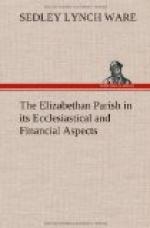Sometimes also certain houses or lands are spoken of as yielding so much a year for the repair of the church and the support of the poor.[306] Incidentally we might mention—though hardly connected with parish finance—certain payments for church repair, etc., claimed of old by some cathedral churches from the parishes of the diocese. Originally a tax varying from a farthing to a penny for each household (hence the names “smoke farthings,” “hearth penny,” “smoke silver"), the payments were commuted for a small lump sum exacted yearly. Thus we find in the Elizabethan accounts mention of “St. Swithin farthings;"[307] of “Ely farthings;"[308] of “Lincoln farthings,"[309] etc., according to the name of the cathedral to which they were paid; or, again, of “Whitsun farthings;” of “Pentecost farthings,” etc., according to the time of the year at which the payments were made.[310] These payments must not be confused with “Peter’s pence,” which had before the Reformation been paid by English parishes to Rome.[311]
Lastly the mother parish church, in large parishes requiring chapels of ease, would exact (when it could) contributions from those congregations who frequented for ordinary divine worship these chapels of ease within the parish. And these exactions would be made irrespective of the fact that these congregations were bound to repair their own chapels and possessed their own churchwardens.[312]
When the means or expedients we have hitherto set forth were found insufficient, or impracticable, or too tardy for an emergency, the parish was compelled to resort to Rates or Assessments.
Assessments were levied in all sorts of ways and for all sorts of purposes. In an emergency, or if the sum to be raised was not large, a levy might be made by the principal men of the parish upon themselves only.[313] A “rate” might, however, be made to collect a very small sum, as well as a very large one.[314] All kinds of units or rules of assessment were resorted to from parish to parish, and (apparently) sometimes no fixed unit at all was taken, men’s ability to pay being roughly gauged, or a man being permitted to rate himself,[315] or give his “benevolence.”
In the wardens’ accounts are frequently seen long lists of names, each being taxed at a sum varying from 1/2d. to three or four shillings. Such lists may represent an attempt to tax each man at 1/2d. or 1d. in the pound, or, likely as not, it may merely mean a crude sizing up of the ability of each to contribute.
Furthermore, a “rate” might consist in a fixed sum, the same for all, and levied by polls or by households,[316] say 1d. or 2d. each. Or, again, it might be levied by pews at varying sums.[317] Assessments to pay the parish clerk or sexton might sometimes be made in kind, and issue from households, from cottages, or from ploughlands: so much corn at Easter, so much bread, so many eggs.[318]




